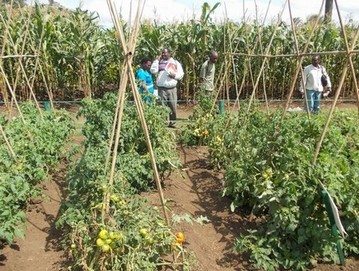
- different cultures,
- appropriate and modern farming practices and technologies,
- appropriate and modern livestock keeping practices and technologies,
- appropriate and modern technologies in beekeeping and fish farming
- appropriate techniques in agro forestry practices
- appropriate and modern technologies in managing horticulture at small scale/household levels e.g. kitchen gardening
- appropriate and modern technologies in food processing including preserving and packaging of fruits, vegetables and other cereal crops
- success and challenges experienced by different development initiative groups elsewhere within and out side the country
- appropriate management of water drops for productive uses at household
With stands distributed on several hectares and hundreds of exhibitors, all the horizons and all the types of agriculture are represented; of big and small scale firms exposing multiple successes and challenges to be learned by farmers. The exhibition comes as a home to find new ideas and initiatives to increase yield on agricultural production and significantly a starting point to improve the quality and quantity of what we produce at our own localities.
| Kateri and three villagers from Same District at Nane Nane Arusha - Njiro Exhibition 8th August, 2014 | Besides eye witness and touches, a lot of information was given to the farmers. The question is what next step after the Nane Nane. |
| Small scale gardening at home environment allows for application of sustainable organic farming practices. The above and left pictures of vegetables are managed demonstratively as organically raised kitchen gardens. | A Modern beekeeping encompasses the use of modern beehives and other tools improved tools. “Honey is Money” |
| The pumping irrigation system would be better managed (even in drought prone areas) through appropriate management of run-off water by use of plastic reservoirs, laid onto the excavated ground reservoir so as to collect the run-off waters. An expensive motorized system to ensure water treatment and application of fertilizer may be used or not by a farmer who applies this irrigation system; this depends on the ability to buy such filtration and fertilizing machines. However, the reservoir is very applicable for run-off water harvesting and management. The size of the plastic reservoir to purchase depends on the size and volume of the ground excavated reservoir, a farmer prefers to maintain. | Thanks to donors/development partners or individuals who will be interested to support our local rural farmers’ development initiative groups residing in Same district, the very drought prone areas. |
Animal husbandry practices in relation to power energy production
| The breeding of domesticated animals was also put in the honor, for example an exposure of dairy cattle, the most productive ones. | The exhibitors demonstrated on the quality and relevant hut constructed for the animals should be designed and easily manageable by a normal farmer in a rural village. The potentials of linking between dairy cattle project and production of biogas for cooking and lighting at the house and the surroundings were well elaborated. |
(Reference from: An Overview of energy sector in rural Tanzania, Workshop on Innovations in off-grid lighting products and energy services for rural Tanzania, by N.C.X. Mwihava, 8th -9th April 2010)
Energy is a basic need for human development. It is a major input for successful family and for implementation of MKUKUTA and MKUZA, sector policies programs in Tanzania. Biogas is one of the major energy components in Tanzania.
Energy policy in Tanzania:
Energy policy in Tanzania is to provide an input in the development process by establishing an efficient energy production, promotion of transportation, distribution and end-user systems in an environmentally sound manner and with due regard to gender issues.
Biomass in Tanzania includes animal droppings from 17.5 million cattle, 12.5 million goat and 3.5 million sheep - biogas (1998 census), 15 million tons p.a. of crop residues, 200,000 tons of VS of sisal waste and 1.1 million tons p.a. of forest residues.
Biomass based in Tanzania:
- Sustainable biomass yield per annual is estimated (data in 2010) at 23.3 million M3.
- Annual demand is around 40 million M3 for households.
- Annual deficit is 15.7 M3 that is harvested by causing deforestation (over 392,000 ha cleared at 40M3 /ha.
- Currently total population relying on biomass fuel for cooking are:
- Charcoal 4,486, 235 (14%)
- 2 million people currently rely on fire woods for lighting
- Biomass meets 90% of energy needs in Tanzania. 40% cooking needs in Peri-Urban areas. 96% cooking needs of rural population.
Energy consumption in rural Tanzania
- Cooking - >90% wood fuel energy (per capital is 1m3 p.a.) biogas, kerosene, gel fuel (motopoa) etc
- Lighting - ≥2% kerosene, electricity, dry cell batteries, solar PV, biogas, firewood, candles (insignificant) etc
- Agro processing – wood fuel, Solar, electricity (grid & captive generators)
- Space heating – mainly wood fuel
- Water heating – wood fuel & limited solar thermal
- The poor spend about 35% of their income on energy with the Tanzanian Program of domestic Biogas. Which is already implanted in already 8800 families with 4 years.





















 RSS Feed
RSS Feed
